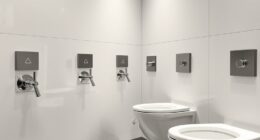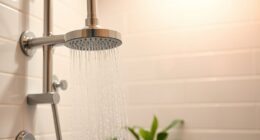Have you ever been faced with the frustrating problem of a blocked toilet? Well, fear not! I’m here to guide you through the process of fixing it yourself.
In this article, I will share essential tools, step-by-step instructions, and effective techniques for unclogging your toilet. By the end, you’ll have the knowledge and confidence to tackle this common household issue.
So, let’s dive in and get your toilet back to its pristine state!
Key Takeaways
- Improper disposal of waste and non-flushable items is a common cause of toilet blockages.
- Essential tools for unclogging a toilet include a plunger and bucket, and prevention is important through mindful flushing and regular maintenance.
- A step-by-step guide can help in clearing a blocked toilet, and calling for emergency plumber services may be necessary for severe blockages.
- Techniques for dislodging stubborn blockages include using a toilet auger or plumbing snake, utilizing plunging techniques, and trying chemical solutions or homemade mixtures.
Understanding the Common Causes of Toilet Blockages
You may be wondering, ‘What are the common causes of toilet blockages?’
Toilet blockages can occur due to a variety of reasons, but the most common cause is the improper disposal of waste and non-flushable items. People often flush items like sanitary napkins, wipes, or excessive amounts of toilet paper, which can lead to clogs in the pipes.
Another cause of blockages is the buildup of mineral deposits and sediment in the pipes over time. These deposits can restrict the flow of water and eventually cause a blockage.
Signs of a blocked toilet include slow draining, gurgling sounds, and water rising to the brim when flushed. Understanding the common causes of toilet blockages is essential for effective toilet blockage prevention.
Now, let’s move on to the essential tools and materials for unclogging a toilet.
Essential Tools and Materials for Unclogging a Toilet
To unclog a toilet, you’ll need a plunger and a bucket. These essential tools will help you tackle the job effectively.
However, it’s important to note that prevention is always better than cure when it comes to toilet blockages. To avoid the hassle of unclogging, there are a few simple steps you can take.
Firstly, be mindful of what you flush down the toilet. Avoid flushing items such as wet wipes, cotton balls, or excessive toilet paper.
Secondly, regular maintenance is key. Use a toilet brush to clean the inside of the bowl and remove any buildup that could lead to blockages.
Finally, consider eco-friendly unclogging methods. Instead of using harsh chemicals, try using a mixture of hot water and dish soap or a combination of baking soda and vinegar. These methods are not only effective, but also environmentally friendly.
Step-by-Step Guide to Clearing a Blocked Toilet
First, gather the necessary tools such as a plunger and a bucket to clear the blockage in your toilet.
Toilet blockages can be a common problem, but with the right tools and a little know-how, you can fix it yourself.
Before you begin, it’s important to understand some preventative measures to avoid future blockages. Avoid flushing large amounts of toilet paper at once, as this can clog the pipes. Also, refrain from flushing items like sanitary products, baby wipes, or paper towels, as these can cause blockages as well.
If the blockage is severe and you are unable to clear it yourself, it may be time to call for emergency plumber services. They have the expertise and equipment to resolve more complex blockages.
Effective Techniques for Dislodging Stubborn Blockages
When confronted with a stubborn blockage, it’s essential to try using a toilet auger to dislodge the obstruction. This specialized tool, also known as a plumbing snake, is specifically designed to navigate through the curves of the toilet’s drain and break apart or remove any clogs in its path. By inserting the auger into the toilet bowl and turning the handle in a clockwise motion, you can effectively break up the blockage and restore proper flow.
To further aid in the removal of stubborn blockages, consider employing the following techniques:
-
Utilize plunging techniques: Using a toilet plunger with a flange, create a tight seal around the drain and vigorously plunge up and down to create suction and dislodge the obstruction.
-
Try chemical solutions: Certain chemical drain cleaners or homemade mixtures can be poured into the toilet bowl to dissolve or break down the blockage. Follow the instructions carefully and allow the solution to sit for the recommended amount of time before flushing.
Preventing Future Toilet Blockages: Maintenance Tips and Tricks
Regularly maintaining your toilet by performing simple tasks like cleaning the bowl and checking the water flow can help prevent future blockages. Toilet blockages can be a major inconvenience and can lead to costly repairs.
To prevent these issues, it is important to follow some best practices. Firstly, make sure to clean the toilet bowl regularly using a toilet brush and a mild cleaner. This will help remove any buildup that could potentially cause blockages.
Secondly, check the water flow in your toilet. If you notice slow draining or weak flushing, it could be a sign of a blockage forming.
Finally, avoid flushing items that are not meant to be flushed, such as wipes, feminine products, or excessive toilet paper.
Frequently Asked Questions
Can I Use Chemical Drain Cleaners to Unclog My Toilet?
Yes, you can use chemical drain cleaners to unclog your toilet. However, there are alternative solutions that can be more effective and less harmful to your plumbing system.
How Do I Know if the Blockage Is Located in the Toilet Bowl or in the Drain Pipe?
When dealing with a clogged toilet, it’s important to determine if the blockage is in the bowl or the drain pipe. Look for signs such as slow drainage or water backing up to pinpoint the source.
Is It Safe to Use a Plunger if the Toilet Is Completely Clogged?
Yes, it is safe to use a plunger if the toilet is completely clogged. However, if you’re looking for plunger alternatives or concerned about potential dangers, there are other methods to unclog a toilet.
What Should I Do if the Water Level in the Toilet Bowl Keeps Rising After Flushing?
If the water level in the toilet bowl keeps rising after flushing, turn off the water supply valve behind the toilet. This will prevent toilet bowl overflow. Then, call a professional plumber for assistance.
Can Flushing Too Much Toilet Paper Cause a Blockage?
Yes, flushing too much toilet paper can cause a blockage. It’s important to use toilet paper alternatives like wet wipes or bidets to prevent this. Other causes of toilet blockages include foreign objects and excessive waste.
Conclusion
In conclusion, mastering the art of unclogging a blocked toilet is like unraveling a perplexing puzzle. Armed with a trusty plunger and a dash of determination, I have emerged victorious against the forces of clogged pipes.
By understanding the common causes of toilet blockages and employing effective techniques, I have triumphed over stubborn blockages and restored the flow of tranquility to my bathroom sanctuary.
Remember, prevention is key – embrace the maintenance tips and tricks to ensure a future free from the clutches of toilet blockages.
Happy plunging!










